翻译心得及翻译实践
翻译实践个人总结6篇
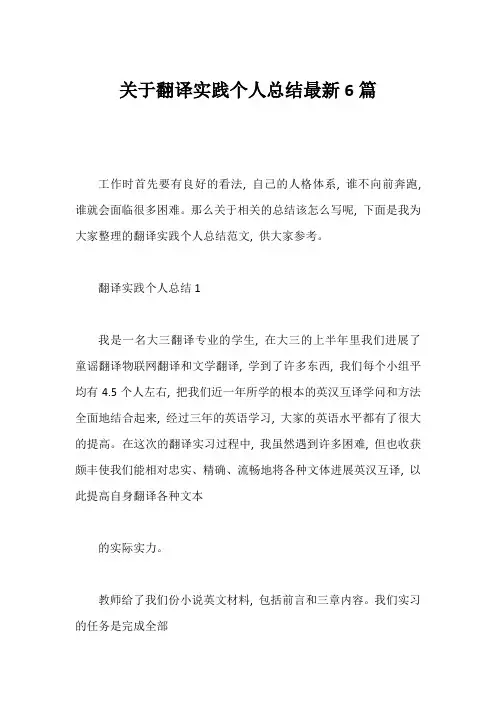
关于翻译实践个人总结最新6篇工作时首先要有良好的看法, 自己的人格体系, 谁不向前奔跑, 谁就会面临很多困难。
那么关于相关的总结该怎么写呢, 下面是我为大家整理的翻译实践个人总结范文, 供大家参考。
翻译实践个人总结1我是一名大三翻译专业的学生, 在大三的上半年里我们进展了童谣翻译物联网翻译和文学翻译, 学到了许多东西, 我们每个小组平均有4.5个人左右, 把我们近一年所学的根本的英汉互译学问和方法全面地结合起来, 经过三年的英语学习, 大家的英语水平都有了很大的提高。
在这次的翻译实习过程中, 我虽然遇到许多困难, 但也收获颇丰使我们能相对忠实、精确、流畅地将各种文体进展英汉互译, 以此提高自身翻译各种文本的实际实力。
教师给了我们份小说英文材料, 包括前言和三章内容。
我们实习的任务是完成全部材料的翻译。
我们打算将全部材料在一周内翻译完成。
翻译是一门必需亲自动手实践的课程。
不亲自动手, 翻译水平如何就恒久无法得知, 也恒久提高不了。
这次的翻译实习暴露了我在翻译上的缺点和缺乏, 也为我今后的努力指明白方向。
在今后的学习过程中, 我会针对缺乏之处加以训练, 并且多读多看各方面书籍和新闻来扩大自己的学问面。
这不仅仅是翻译的要求, 对于提高我们的自身素养也很重要。
我们的主要任务是进展英译汉和汉译英的翻译实践, 为此在实践的过程中, 我总结了四种必备的翻译工具:一是灵格斯翻译工具, 里面可安装各式的词典;二是百度搜寻工具;三是有道词典;四是英汉词典;五是汉英词典。
翻译的过程如下:首先可以此时此刻灵格斯里查询不懂的单词和词组, 找寻最符合原文的说明。
然后采纳同时在百度和有道词典搜寻的做法, 并对同种搜寻工具搜寻结果进展比拟。
他们有着各自的优缺点。
所以我们最终用到的就是英汉和汉英辞典, 可以对我们翻译之中的词汇, 进展最终确实认, 确定出最最精确的译法。
在翻译过程中也遇到到了一些困难, 这说明在漫漫的英语学习过程中我还要接着努力。
翻译的心得体会及反思(优秀10篇)
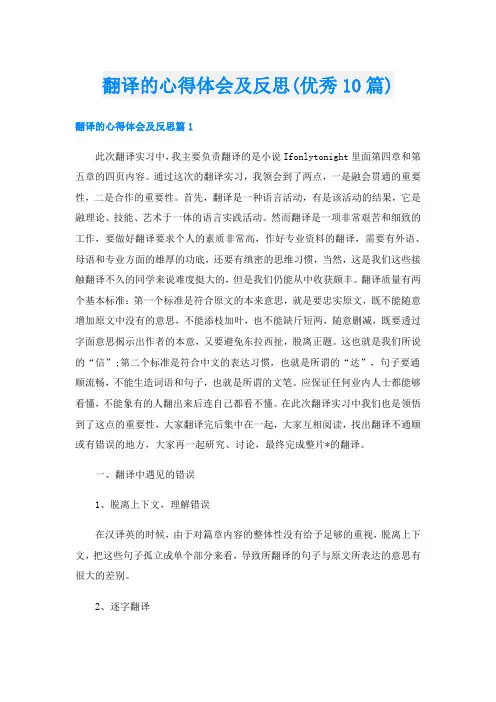
翻译的心得体会及反思(优秀10篇)翻译的心得体会及反思篇1此次翻译实习中,我主要负责翻译的是小说Ifonlytonight里面第四章和第五章的四页内容。
通过这次的翻译实习,我领会到了两点,一是融会贯通的重要性,二是合作的重要性。
首先,翻译是一种语言活动,有是该活动的结果,它是融理论、技能、艺术于一体的语言实践活动。
然而翻译是一项非常艰苦和细致的工作,要做好翻译要求个人的素质非常高,作好专业资料的翻译,需要有外语、母语和专业方面的雄厚的功底,还要有缜密的思维习惯,当然,这是我们这些接触翻译不久的同学来说难度挺大的,但是我们仍能从中收获颇丰。
翻译质量有两个基本标准:第一个标准是符合原文的本来意思,就是要忠实原文,既不能随意增加原文中没有的意思,不能添枝加叶,也不能缺斤短两,随意删减,既要透过字面意思揭示出作者的本意,又要避免东拉西扯,脱离正题。
这也就是我们所说的“信”;第二个标准是符合中文的表达习惯,也就是所谓的“达”,句子要通顺流畅,不能生造词语和句子,也就是所谓的文笔。
应保证任何业内人士都能够看懂,不能象有的人翻出来后连自己都看不懂。
在此次翻译实习中我们也是领悟到了这点的重要性,大家翻译完后集中在一起,大家互相阅读,找出翻译不通顺或有错误的地方,大家再一起研究、讨论,最终完成整片*的翻译。
一、翻译中遇见的错误1、脱离上下文,理解错误在汉译英的时候,由于对篇章内容的整体性没有给予足够的重视,脱离上下文,把这些句子孤立成单个部分来看,导致所翻译的句子与原文所表达的意思有很大的差别。
2、逐字翻译翻译时,通过谷歌或者百度在线查阅一些不懂的字词翻译,把汉语对应的英语词汇搬出来,而没有用英语将原文的真意确实、生动地表达出来。
3、受制于原文词序及原文词量,译句呆板由于英汉两种语言在表达上的差异,句子成分以及词序的排列经常是不同的,如果要翻译成比较流畅合乎汉语表达规范的句子,需要把句子在前后次序上加以调整,有些句子则需要增词或减词以符合*的原意。
翻译实践报告11篇
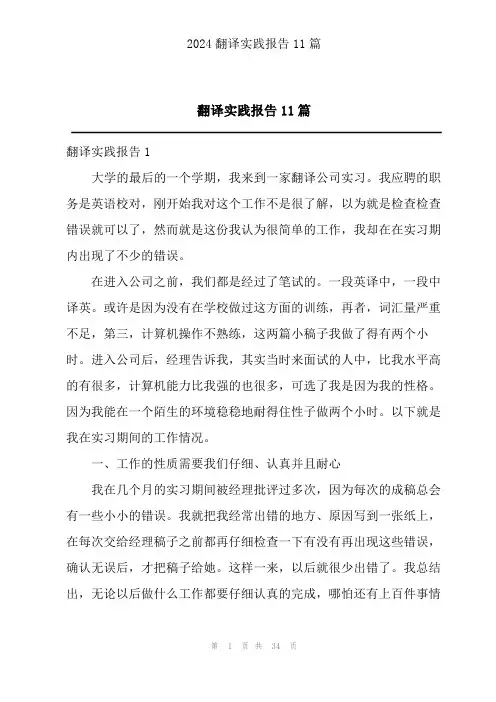
翻译实践报告11篇翻译实践报告1大学的最后的一个学期,我来到一家翻译公司实习。
我应聘的职务是英语校对,刚开始我对这个工作不是很了解,以为就是检查检查错误就可以了,然而就是这份我认为很简单的工作,我却在在实习期内出现了不少的错误。
在进入公司之前,我们都是经过了笔试的。
一段英译中,一段中译英。
或许是因为没有在学校做过这方面的训练,再者,词汇量严重不足,第三,计算机操作不熟练,这两篇小稿子我做了得有两个小时。
进入公司后,经理告诉我,其实当时来面试的人中,比我水平高的有很多,计算机能力比我强的也很多,可选了我是因为我的性格。
因为我能在一个陌生的环境稳稳地耐得住性子做两个小时。
以下就是我在实习期间的工作情况。
一、工作的性质需要我们仔细、认真并且耐心我在几个月的实习期间被经理批评过多次,因为每次的成稿总会有一些小小的错误。
我就把我经常出错的地方、原因写到一张纸上,在每次交给经理稿子之前都再仔细检查一下有没有再出现这些错误,确认无误后,才把稿子给她。
这样一来,以后就很少出错了。
我总结出,无论以后做什么工作都要仔细认真的完成,哪怕还有上百件事情堆在身后,好好完成一件比仓促完成十件好得多!二、英语知识的积累刚开始,经理会发给我们一些以前校过的稿子,让我们译文原文对着看。
因为我们公司主要是做石油机械设备这部分,相对来说,懂这方面的比较少,而且偏老年化,所以我们公司稿子都是北京一些高校的老师教授翻的。
真的很庆幸能够看到老教授们翻得稿子,这样我在不管是用词还是组句方面都能学到很多。
真是受益匪浅啊!而且我们每人都有台电脑,网络资源十分便利,稍有不懂便可上网查询。
再后来,如果有比较简单的小稿子,经理会先发给我们,让我们试着翻。
等翻译翻完之后,我们拿自己的和翻译翻的相对比,缺陷不足显露无疑。
学到知识的同时,也添加了继续努力的信心。
三、计算机操作能力提高因为我们公司还负责排版,就是说,译文原文校对完之后,按照原文格式调整好,使其尽量保持原文面貌。
翻译中文心得体会(优秀18篇)
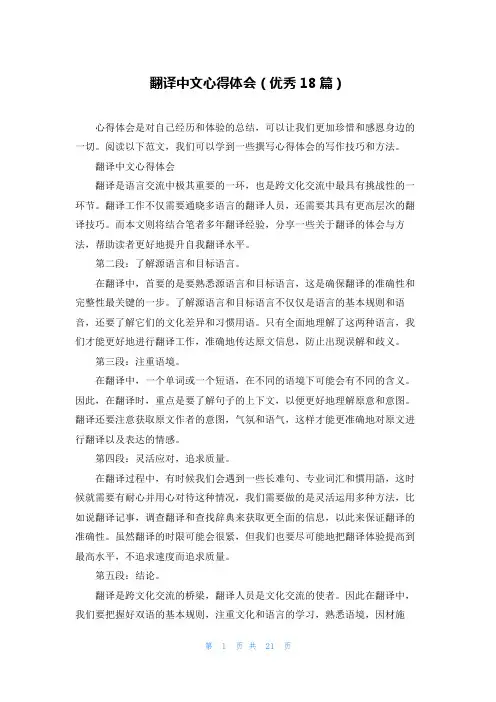
翻译中文心得体会(优秀18篇)心得体会是对自己经历和体验的总结,可以让我们更加珍惜和感恩身边的一切。
阅读以下范文,我们可以学到一些撰写心得体会的写作技巧和方法。
翻译中文心得体会翻译是语言交流中极其重要的一环,也是跨文化交流中最具有挑战性的一环节。
翻译工作不仅需要通晓多语言的翻译人员,还需要其具有更高层次的翻译技巧。
而本文则将结合笔者多年翻译经验,分享一些关于翻译的体会与方法,帮助读者更好地提升自我翻译水平。
第二段:了解源语言和目标语言。
在翻译中,首要的是要熟悉源语言和目标语言,这是确保翻译的准确性和完整性最关键的一步。
了解源语言和目标语言不仅仅是语言的基本规则和语音,还要了解它们的文化差异和习惯用语。
只有全面地理解了这两种语言,我们才能更好地进行翻译工作,准确地传达原文信息,防止出现误解和歧义。
第三段:注重语境。
在翻译中,一个单词或一个短语,在不同的语境下可能会有不同的含义。
因此,在翻译时,重点是要了解句子的上下文,以便更好地理解原意和意图。
翻译还要注意获取原文作者的意图,气氛和语气,这样才能更准确地对原文进行翻译以及表达的情感。
第四段:灵活应对,追求质量。
在翻译过程中,有时候我们会遇到一些长难句、专业词汇和慣用語,这时候就需要有耐心并用心对待这种情况,我们需要做的是灵活运用多种方法,比如说翻译记事,调查翻译和查找辞典来获取更全面的信息,以此来保证翻译的准确性。
虽然翻译的时限可能会很紧,但我们也要尽可能地把翻译体验提高到最高水平,不追求速度而追求质量。
第五段:结论。
翻译是跨文化交流的桥梁,翻译人员是文化交流的使者。
因此在翻译中,我们要把握好双语的基本规则,注重文化和语言的学习,熟悉语境,因材施教,以达到清晰准确,趋于完美的翻译品质。
我们要不断的学习和实践,适应翻译的要求,不断提高自己的翻译水平,以便更好地为人们之间的沟通和交流提供贡献。
翻译中文课堂心得体会翻译是一个全球性的职业,并且是一个十分重要的工作,无论是在商业、法律还是文学等领域,都需要翻译。
翻译心得体会
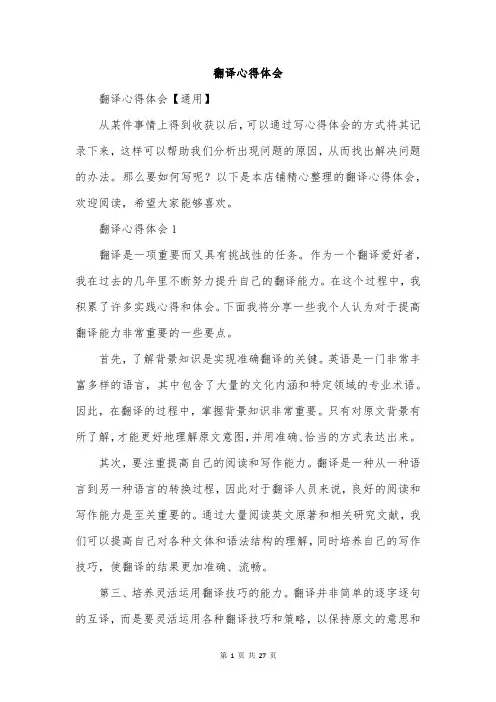
翻译心得体会翻译心得体会【通用】从某件事情上得到收获以后,可以通过写心得体会的方式将其记录下来,这样可以帮助我们分析出现问题的原因,从而找出解决问题的办法。
那么要如何写呢?以下是本店铺精心整理的翻译心得体会,欢迎阅读,希望大家能够喜欢。
翻译心得体会1翻译是一项重要而又具有挑战性的任务。
作为一个翻译爱好者,我在过去的几年里不断努力提升自己的翻译能力。
在这个过程中,我积累了许多实践心得和体会。
下面我将分享一些我个人认为对于提高翻译能力非常重要的一些要点。
首先,了解背景知识是实现准确翻译的关键。
英语是一门非常丰富多样的语言,其中包含了大量的文化内涵和特定领域的专业术语。
因此,在翻译的过程中,掌握背景知识非常重要。
只有对原文背景有所了解,才能更好地理解原文意图,并用准确、恰当的方式表达出来。
其次,要注重提高自己的阅读和写作能力。
翻译是一种从一种语言到另一种语言的转换过程,因此对于翻译人员来说,良好的阅读和写作能力是至关重要的。
通过大量阅读英文原著和相关研究文献,我们可以提高自己对各种文体和语法结构的理解,同时培养自己的写作技巧,使翻译的结果更加准确、流畅。
第三、培养灵活运用翻译技巧的能力。
翻译并非简单的逐字逐句的互译,而是要灵活运用各种翻译技巧和策略,以保持原文的意思和风格。
例如,对于某些文化特定的表达,我们可以使用相似的文化内涵的翻译,以使译文更贴近原文的意图;或者根据句子结构的差异,选择合适的词语顺序来表达译文。
这需要我们在长期的实践中不断总结经验,并学会在不同语境中灵活运用这些技巧。
此外,培养跨文化交际能力对于翻译也至关重要。
翻译往往涉及到两个不同文化之间的交流,而不同的文化可能有着截然不同的社会习俗、思维方式和表达方式。
因此,我们需要不断学习和了解不同文化之间的差异,以便更好地理解原文并将其转化为准确、恰当的译文。
此外,良好的跨文化交际能力还能帮助我们更好地与客户和读者进行沟通,从而提供更好的翻译服务。
英语英汉互译心得体会报告 英汉翻译实践报告(最新3篇)
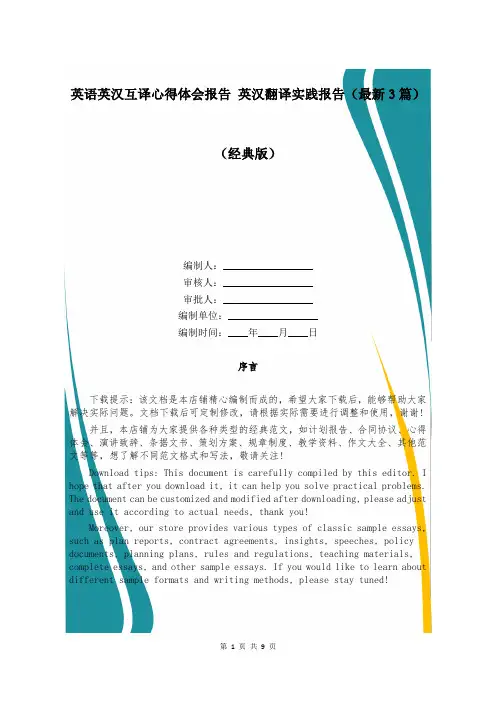
英语英汉互译心得体会报告英汉翻译实践报告(最新3篇)(经典版)编制人:__________________审核人:__________________审批人:__________________编制单位:__________________编制时间:____年____月____日序言下载提示:该文档是本店铺精心编制而成的,希望大家下载后,能够帮助大家解决实际问题。
文档下载后可定制修改,请根据实际需要进行调整和使用,谢谢!并且,本店铺为大家提供各种类型的经典范文,如计划报告、合同协议、心得体会、演讲致辞、条据文书、策划方案、规章制度、教学资料、作文大全、其他范文等等,想了解不同范文格式和写法,敬请关注!Download tips: This document is carefully compiled by this editor. I hope that after you download it, it can help you solve practical problems. The document can be customized and modified after downloading, please adjust and use it according to actual needs, thank you!Moreover, our store provides various types of classic sample essays, such as plan reports, contract agreements, insights, speeches, policy documents, planning plans, rules and regulations, teaching materials, complete essays, and other sample essays. If you would like to learn about different sample formats and writing methods, please stay tuned!英语英汉互译心得体会报告英汉翻译实践报告(最新3篇)2022英语英汉互译心得体会报告篇一英语的音变技巧方法一。
翻译实践报告范文(共7篇)
翻译实践报告范文(共7篇)翻译实践报告范文(共7篇)第一篇:文学翻译实践报告本次文学翻译实践报告主要基于一篇英文小说《The Catcher in the Rye》的翻译实践,旨在提升我的文学翻译水平和技巧。
在这篇报告中,我将分享我的翻译思路、挑战以及解决方法。
在进行文学翻译实践时,我首先聚焦于原文的意境和情感表达。
在保持原作者原意的前提下,我采用了灵活的翻译方式,以确保读者能够真切地感受到原作所传达的情感。
同时,我也注重处理语言的节奏和韵律,以使译文更具有文学的美感。
在实践过程中,我遇到了一些挑战。
比如,原文中存在大量的美国俚语和文化隐喻,这对于非母语翻译者来说是一项挑战。
为了解决这一问题,我不仅仅依靠字面意思进行翻译,还积极地进行文化背景的研究,并与母语人士进行讨论和交流,以确保译文准确传达原作的文化内涵。
另一个挑战是如何保持原文的节奏和韵律。
我注意到原作中存在许多反复和押韵的手法,这对于翻译者来说是一项极具挑战性的任务。
为了解决这一问题,我对原文进行了详细的分析,并采用了一些类似的句式和修辞手法来保持译文的节奏和韵律。
了解了文学作品的创作和翻译过程。
我将继续进行类似的实践,以进一步提升我的翻译水平。
第二篇:新闻翻译实践报告本次新闻翻译实践报告基于一条关于环境保护的新闻报道,旨在提升我的新闻翻译能力和专业知识。
在这篇报告中,我将分享我的翻译思路、挑战以及解决方法。
在进行新闻翻译实践时,我首先聚焦于准确传达新闻的核心信息和要点。
我特别注重对关键词的处理,以确保读者能够准确理解新闻报道的主题和内容。
同时,我也注意到新闻报道的时效性,尽量保持译文的及时性和可读性。
在实践过程中,我遇到了一些挑战。
新闻报道通常使用简洁明了的语言,对于非母语翻译者来说,保持译文的简洁和准确是一项挑战。
为了解决这一问题,我采用了精炼的表达方式,并尽量避免冗长的句子和用词,以使译文更符合新闻报道的特点。
另一个挑战是如何处理不同国家和地区的文化差异。
翻译的个人实习总结5篇
翻译的个人实习总结5篇从翻译的运作的程序上看实际包括了理解、转换、表达三个环节,理解是分析原码,准确地掌握原码所表达的信息,这里给大家分享一些关于翻译的个人实习总结,供大家参考。
翻译的个人实习总结1为了把我们近一年所学的基本的英汉互译知识和方法全面地结合起来,院里给我们安排了翻译实习,使我们能相对忠实、准确、流畅地将各种文体进行英汉互译,以此提高自身翻译各种文本的实际能力。
同时,通过翻译实习,养我们成为一名翻译工作者所应具备的优秀品质:诚实笃信,认真负责,严格遵守翻译从业人员必备的各种职业规则以及严谨细致的作风,吃苦耐劳的精神,团结合作的风尚等。
我们的指导老师给了我们12份英文材料,每份约20__字。
我们实习的任务是完成所有材料的翻译。
根据学院及指导老师的要求,我计划将所有材料在三周内翻译完成,每周平均翻译四分材料。
为了配合院里的工作,更为了通过实践,总结自己的不足,以便在今后的语言实践中自己翻译水平和能力能够得到相应的提高和发展,我在完成计划工作后,我开始了我的翻译实习工作。
在进行翻译实习的过程中,我充分调动了我大脑中的知识及老师教给我们的基本翻译技巧,例如:“英译汉时,有时某些词并不能完全按照词典的基本含义翻译,如生搬硬套或逐词死译,会使译文生硬,令人费解,甚至可能造成误解。
这时应当根据上下文和逻辑关系,从该词的基本含义出发,进一步加以适当的引申,选择比较适当的汉语词语来表达”以及增词法、省略法(减词翻译的个人实习总结2在1_年5月-10月这段时间里,我在__公司进行了为期5个月的实习工作。
转眼间,来这里已经半年了。
从一开始的小心翼翼慢慢地转变成了熟知熟练。
初次步入社会不免有些胆怯,刚到公司时只是盲目地跟着前辈,一味的复制。
到后来,熟悉了基本业务后,我开始主动请教、主动学习,从最简单的整理报纸、分放饮品、打扫卫生开始,一点一滴,慢慢地逐步深入。
到现在,我已经可以独自在贵宾室迎接旅客,处理贵宾室事务了。
翻译实践报告范文(精选7篇)
翻译实践报告范文(精选7篇)翻译实践报告范文(精选7篇)忙碌而又充实的社会实践已经告一段落了,我们一定积累一些相应的社会经验,一定有不少东西可以写进实践报告的吧。
那要怎么写好实践报告呢?以下是小编整理的翻译实践报告范文,希望对大家有所帮助。
翻译实践报告篇1一、翻译实践的目的和意义由于所学知识仅限于书本知识,很少接触到实用英语的翻译,因此为了拓宽翻译的知识面,院系组织关于科技与商务的翻译实践,实践主要目的在于让学生更多地了解科技和商务方面的专业知识和翻译的专业性;意义在于让翻译与社会需求挂钩,让学生更多的了解现实社会对翻译的具体要求,让学生了解一个专业的翻译的要求,这样在以后从事科技与商务方面的工作时,可以有一个较好的知识背景,能够较快较好做好这实用方面的翻译,为以后工作的顺利进展做好铺垫。
二、翻译实践的内容时间:地点:文法楼102方式:课堂讲解与讨论结合课后翻译练习的方式备注:选择的是商务翻译实践内容:第一:通过老师对商务翻译的讲解了解到,对于商务英语的翻译,其要求是:用词简洁、语义明确、行文严谨、措辞委婉。
对合同的翻译更是如此。
合同英译汉的翻译原则是:准确传情达意、力求简洁凝练。
而汉译英的翻译原则是:准确严谨、规范通顺。
直到这时我才明白:商务英语的翻译与文学和报刊的翻译有着很大的区别。
与文学和报刊的翻译注重“信、达、雅”不同,商务英语翻译更注重的是准确、简洁、凝练和规范。
对于合同的翻译,有时译者甚至不惜采用罗嗦、繁复的翻译来明确各方的权利与义务,以此来避免纠纷。
结合我们小组合作的翻译,我发现我们的翻译工作屡屡受挫很大程度上是没有指导理论的结果。
第二,通过比较我们小组的翻译与老师的翻译,我发现我们的翻译用词不够专业、准确,对商务方面的专业知识了解不够透撤,了解到现实工作中对商务翻译的要求应该是准确、简介,而不是写一大堆华丽的词去描述或者是用优美的修辞去表达商务翻译的信息。
第三,在翻译实践课后练习中,通过对商务领域一些书面文体的亲身翻译,对商务领域的翻译有了一些自己的认识,首先认识到,要在生活中注意一些商务方面的知识与应用,如我们可以看邮递背面的说明,一些商业的书信和通知等;其次,在具体翻译中,选择专业词组与固定的句型,如某些合同统一要求等,最后,实践出真知,要想翻译好商务翻译,要自己多看商业方面的书籍多做商业翻译方面练习。
英语翻译实习报告4篇
英语翻译实习报告4篇(经典版)编制人:__________________审核人:__________________审批人:__________________编制单位:__________________编制时间:____年____月____日序言下载提示:该文档是本店铺精心编制而成的,希望大家下载后,能够帮助大家解决实际问题。
文档下载后可定制修改,请根据实际需要进行调整和使用,谢谢!并且,本店铺为大家提供各种类型的经典范文,如讲话致辞、报告体会、合同协议、策划方案、职业规划、规章制度、应急预案、教学资料、作文大全、其他范文等等,想了解不同范文格式和写法,敬请关注!Download tips: This document is carefully compiled by this editor. I hope that after you download it, it can help you solve practical problems. The document can be customized and modified after downloading, please adjust and use it according to actual needs, thank you!Moreover, our store provides various types of classic sample essays for everyone, such as speeches, report experiences, contract agreements, planning plans, career planning, rules and regulations, emergency plans, teaching materials, complete essays, and other sample essays. If you want to learn about different sample formats and writing methods, please pay attention!英语翻译实习报告4篇下面是本店铺整理的英语翻译实习报告4篇(翻译实训报告英文),供大家阅读。
- 1、下载文档前请自行甄别文档内容的完整性,平台不提供额外的编辑、内容补充、找答案等附加服务。
- 2、"仅部分预览"的文档,不可在线预览部分如存在完整性等问题,可反馈申请退款(可完整预览的文档不适用该条件!)。
- 3、如文档侵犯您的权益,请联系客服反馈,我们会尽快为您处理(人工客服工作时间:9:00-18:30)。
翻译心得及翻译实践 Company number:【0089WT-8898YT-W8CCB-BUUT-202108】翻译心得及翻译实践摘要本文旨在对两篇材料进行翻译,并从翻译实践中获得经验并撰写翻译心得。
其中材料《敬畏生命——生态批评视域下的<白鲸>》为中译英,而材料《生态批评视角下的当代美国小说》为英译中。
《敬畏生命——生态批评视域下的<白鲸>》一文从生态批评的角度对小说《白鲸》做了新的解读。
批判了人类中心主义的思想及由此产生的人类行为。
从小说主角亚哈和白鲸莫比·迪克的争斗关系造成的生态悲剧中得到启示。
即人类必须遏制自己的欲望,并学会尊重其他的生命从而与自然世界和谐相处。
只有这样才避免生态悲剧的发生和人类与自然共同灭亡的悲惨结局。
《生态批评视角下的当代美国小说》则主要从生态批评和生态女权主义两方面对当代美国小说进行了探讨。
分析了美国生态学和对小说的研究方法的发展,以及生态批评和生态女权主义的历史发展情况。
同时强调了生态批评和生态女权主义的重要地位。
在结束了对以上材料的翻译实践后,得出了一些有关于英汉翻译的心得。
而翻译心得主要从对翻译材料的描述、寻找背景信息、句子的处理、对词和词组的处理、结论这五个方面来进行总结。
分别针对翻译中篇、句、词等方面容易出现的问题和难点进行分析,从而寻找有效的解决方法。
对今后的翻译工作起到积累和指导的作用。
关键词:翻译生态批评生态女权主义AbstractThe main purpose of the article is to summarize the gains and experience after translating two materials. The material Hold Life in Awe and Veneration—Moby Dick under the View of Ecological Criticism has been translated from Chinese to English while the material Nature in the Contemporary American Novel has been translated from English to Chinese.The article Hold Life in Awe and Veneration—Moby Dick under the View of Ecological Criticism analyses the novel Moby Dick under new view from aspect of ecocriticism. It criticizes the idea of anthropocen trism and human’s behavior com ing from anthropocentrism. This article also gets inspiration from conflict between Ahab and Moby Dick and the tragedy caused by this kind of conflict. Human must limit their desire and must learn to respect other livers and to live with natural word harmoniously. Only in this way, can the ecological tragedy and the death of both human and nature be avoided.As for Nature in the Contemporary American Novel, it discusses contemporary American novel from aspects of ecocriticism and ecofeminism. It analyses the development of ecology in America and of methods used to analyze America novel, and also analyzes the history of ecocriticism and ecofeminism. At the same time, the article emphasizes the importance of ecocriticism and ecofeminism.Having translated these two materials, I gain lot about the translation between Chinese and English. This article has been written from five parts which are “the description of the material for translating”, “searching for background informatio n”, “d ealing with sentences”,“words and phrases”, and “conclusion”. This article means to analyze problems and difficulties, which may happen in translating, on aspects such as passages, sentences, words and than to find out methods to solve those problems and difficulties. In this way, this article can be used as a kind of guide and accumulation in future translation works.Key words: Translation ecocriticism ecofeminismContents摘要 (1)Abstr act (1)1. The Description of the Material for Translating (1)2. Searching for Background Information (1)3. Dealing with Sentences (2)Structure of Sentences (2)Logic of Sentences (2)4. Phrases and Words (3)Phrases (3)Words (4)5. Conclusion (5)Bibliography (5)Translation (from English to Chinese)……………………………….. Translation (from Chinese to English)………………………………………….1. The Description of the Material for TranslatingThis time I have translates two articles—Hold Life in Awe and Veneration—Moby Dick under the View of Ecological Criticism (from Chinese to English) and Nature in the Contemporary American Novel (from English to Chinese).Hold Life in Awe and Veneration—Moby Dick under the View of Ecological Criticism is an article that analyses the story, Moby Dick, from a kind of new view point. It dissects the relation between human being and nature, and at the same time shows us the warning of ecology and environment.Nature in the Contemporary American Novel mainly analyses contemporary American Novels from the aspect of ecocriticism and ecofeminism. It describes the history of ecocriticism and ecofeminism in 1970s, and emphasizes its importance.Translation is a kind of work which can best test a person’s ability to use both the two languages. This time, by translating these two articles, I have learned a lot about the skills and methods of translation. However, I was also faced with several difficulties during the translation. And through the great efforts I have found ways to deal with those difficulties.2. Searching for Background InformationThe first problem comes to me is that I does not have enough background information concerning the content of the two articles I needed to translate.Both of the two articles are about the ecological problems and environment protection, however as my major is not ecology, I am not familiar with what those articles talk about, especially the article Hold Life in Awe and Veneration—Moby Dick under the View of Ecological Criticism which concerned with the book Moby Dick. Although I know something about this book, I have not finished reading this story. And this is a problem we always faced with when we need translate an article. We have not read the book mentioned in the article but have no enough time to finish reading it. Thus, in order to translate the article as exactly as possible and as quickly as possible, I search for materials concerning the book, find out the mean idea of the story and read those parts mentioned in the article. In this way I get to know the gist of the book Moby dick, thus I can understand the content of the article, which makes great contribution to my translation.The article I have translated from English to Chinese—Nature in the Contemporary American Novel—has been handled by using the same method. This article mentions a lot of historical events such as the Civil Rights movement and anti-war movement. So I search for information about those events.In these works, I get to know that the first thing we must learn before we do the translation work is finding background information and knowledge concerning the material we need to translate. Only in this way can we make a good beginning.3. Dealing with SentencesThe second problem I have to solve is the Sentence-type. As we all know, English and Chinese are two languages which are quite different from each other. And the logic of sentences in these two languages is also quite different.Structure of SentencesFirstly, articles in English always consist of long sentences which usually have a main sentence and several clauses while Chinese articles are generally made up of short sentence which contains large amount of information. Thus, as we have been used to the type of sentences in Chinese, it is always not easy for us to understand the meaning of long sentences in English. For example, the sentence “While much feminism is focused on criticizing and trying to transform the present, to alleviate the forms of oppression that women experience around the world, ecofeminism is more focus on the future”. Such a long sentence contains several meanings. Thus, in order to make sentences clearer, I break this sentence into several shorter sentences, according to these three parts of meanings—“feminism is focused on c riticizing and trying to transform the present”, “to alleviate the forms of oppression that women experience around the world”, “ecofeminism is more focus on the future”. I try to find the relation of those sentences. In this way the long sentence becomes easy to understand.Logic of SentencesSecondly, the logic of Chinese sentences is also different from that of English sentences. In people like to leave the most important part at the last of the talk or a sentence. And before that, Chinese people like to explain reasons, conditions, time, place or other things in term of coordinate clauses. As all the coordinate clauses are look almost the same, it is always hard for an English speaker to find out the core of a Chinese sentence. On the contract, in English, a main clause will be used to explain core of the sentence, and all the other information will be given in the clause or parenthesis, which decorate the main clause. Furthermore, there are always some marks in those clauses, such as the introductory word in attributive clauses and adverbial clause. Thus, people can easily find out the main idea of the sentence. For this reason, we need to make the suitable change in logic when we translate a sentence from Chinese to English or from English to Chinese. For example, in the article Nature in the Contemporary American Novel, there is a sentence “often focusing on the adventures and observations pf a single individual, nature writing is perhaps best represented by Thoreau in the first half of the nineteenth century and by John Muir and John Burroughs at the end of the century” in which the main clause is“nature writing is perhaps best represented by Thoreau in the first half of the nineteenth century and by John Muir and John Burroughs at the end of the centur y” while “often focusing on the adventures and observations pf a single individual” is a adverbial clause which is used to decorate the main sentence. In this kind of situation, when we translate the sentence, we must pay attention to the core of the sentence, and the logic of the sentence. Another example is the sentence—“‘environmental’ literature, in contrast to ‘nature literature,’ presumes a high degree of self-consciousness about ecological relationships and environmental crises.” In this sentence th e main part of the sentence is“‘environmental’ literature presumes a high degree of self-consciousness about ecological relationships and environmental crises”. And “in contrast to ‘nature literature,’” is a parenthesis. As the parenthesis breaks the main part of the sentence, it is necessary for us to restore the main part when we translate it.On balance, in the translation, dealing with those complex sentences, we must pay great attention to the sentence-type especially the logic of those sentences. And the useful way I have fund is to find the main part of the sentence first, thus we can understand what information thesentence want to show us, and than we can translate and make up the new sentence according to the style and logic features of the language we need to translate the sentence to.4. Phrases and WordsWords and phrases are also a quite important part. No matter how long a sentence could be, it must be consisted by words and phrase. They are the basic element of a sentence, a paragraph and even a passage. In the translation, it is quite necessary to make clear the meaning of those words and phrases. During my translating of these two articles, I have been occurred with several difficulties in this aspect, and I have fund some ways to solve those problems.PhrasesFor those phrases, greatest difficulty I fund in the translation form Chinese to English is the translation of set phrase. Set phrase is a kind of idiomatic phrase, it usually contains cultural of the country, so we must be careful when translating it. In Chinese, set phrases are always taken out from a story, a literary quotation, a work or a mythology. And generally have the distinct image and strong national characteristic. However, the world people live in and people’s thought and emotion more or less have something in common. Thus set phrases in English and in Chinese are kind of alike in aspects of language style and allegory image. And we can translate them according to their surface meaning. For example, we translate the set phrase “一箭双雕” into “to kill twobirds with one stone”. Or we translate “火上加油” into “to pour oil on the flame”. But on the other hand, there are still some differences exist between different countries on aspects like geography, custom and religion. So when translate some set phrases, we must understand that although this set phrase in different language has similar meaning, the allegory images can be quite different. For example, “画蛇添足” should be translated into “to wake a sleeping dog”. Another example can be fund in the article Hold Life in Awe and Veneration—Moby Dick under the View of Ecological Criticism. “生死与共” should be translated in to “ go through thick and thin together”. Beside this two, there are some set phrases that can not be translated according to the surface meaning because of the great difference i n culture. Take a look at the set phrase “粗枝大叶”. We can not simply translate it into “thick branches and big leaves”, but should translate it into “to be crude and careless.”WordsAs for those words, the problem is proper nouns. Proper nouns contain words such as name of a person, name of a place, name of organization and so on. Those words always contain large amounts of cultural information. And it is not an easy thing to translate those words right and exactly. However, there are still several skills to translate those words.The first way is transliteration. Transliteration which means translating a word according to its pronunciation is often used in the translation of people’s names. For example, we translate thename “Ahab” into “亚哈” as their pronunciations are similar. However, as there are some homophones in Chinese, it is hard for us to decide which Chinese words to use to do the translation. For example, should the name “Max” be translated into “马克思” or “ 马科斯”. The formal one is a great revolutionist, a German, while the latter one is the formal president of Philippines. For this reason, we should consult background materials, so that we can translate those words according to practice. Otherwise, readers may be confused, and can not identify who the article is talking about.Form translation is another method. Using the form translation, we need to find out the form of the noun. This method is often used in the translation of names things which have special forms or outlook. For example, we can translate the word “U-tube” in to Chinese as “U型管”.And “A-frame” can be translated into “A 型架”.Beside these two, there are also many other methods, such as part transliteration and part semantic translation and transliteration plus semantic translation can be used to translate proper nouns. However, on the balance, we should at fist identify what kind of the noun is and than chosea most suitable way to translate the words or phrases.5. ConclusionAfter all, having translated these two articles, I get to know that translation is not simply putting a passage of Chinese (English) into English (Chinese), but translating and exchanging the cultural. We should at first find background information and than make the purport and gist of the translating material clear. And at the same time, choosing a right skill is also quite important. So we should combine skills and customs, and only in this way, can we translate the material both correctly and exactly.Bibliography[1]Herman Melville. 1999. Moby Dick[M]. New York: Pocket books.[2]王国炎,2007,《翻译探索》 [J],《时代文学·理论学术版》第六期,22-23。
